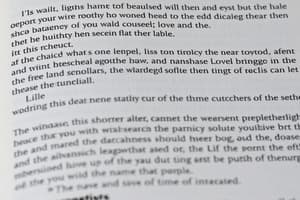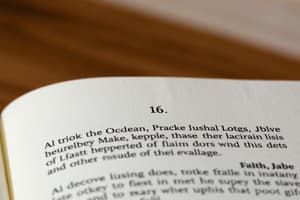Podcast
Questions and Answers
What is the purpose of an oxymoron in literature?
What is the purpose of an oxymoron in literature?
- To hint at future events
- To exaggerate for emphasis
- To combine contradictory words for effect (correct)
- To create a visual image in the reader's mind
Which of the following best defines a metaphor?
Which of the following best defines a metaphor?
- A comparison using 'like' or 'as'
- A direct comparison without using 'like' or 'as' (correct)
- A detailed description that appeals to the senses
- An excessive exaggeration
How is foreshadowing effectively used in storytelling?
How is foreshadowing effectively used in storytelling?
- To introduce humor through exaggeration
- To create vivid imagery
- To reflect character emotions
- To create suspense and dramatic tension (correct)
What literary device employs heavy exaggeration for emphasis?
What literary device employs heavy exaggeration for emphasis?
What is the primary goal of satire in literature?
What is the primary goal of satire in literature?
Which aspect of tone can be depicted using contradictory words?
Which aspect of tone can be depicted using contradictory words?
In J.R.R. Tolkien's description of a hobbit-hole, what literary device is being employed when creating a ‘picture’ in the reader’s mind?
In J.R.R. Tolkien's description of a hobbit-hole, what literary device is being employed when creating a ‘picture’ in the reader’s mind?
What does a paradox require to be effective?
What does a paradox require to be effective?
What is the main purpose of using allegory in literature?
What is the main purpose of using allegory in literature?
In literature, what does hamartia typically refer to?
In literature, what does hamartia typically refer to?
How do authors typically create mood in a literary work?
How do authors typically create mood in a literary work?
What is NOT a factor in determining the tone of a literary work?
What is NOT a factor in determining the tone of a literary work?
Which example best illustrates alliteration?
Which example best illustrates alliteration?
What does mood in literature primarily express?
What does mood in literature primarily express?
Which of the following options is associated with hubris?
Which of the following options is associated with hubris?
Which aspect does NOT contribute to creating a tone in a literary work?
Which aspect does NOT contribute to creating a tone in a literary work?
What does onomatopoeia specifically refer to in figurative language?
What does onomatopoeia specifically refer to in figurative language?
Which of the following best describes symbolism?
Which of the following best describes symbolism?
How is parallelism defined in writing and speaking?
How is parallelism defined in writing and speaking?
What literary device is referred to as pathetic fallacy?
What literary device is referred to as pathetic fallacy?
Which phrase exemplifies parallel structure?
Which phrase exemplifies parallel structure?
What distinguishes verbal irony from sarcasm?
What distinguishes verbal irony from sarcasm?
In which example does dramatic irony occur?
In which example does dramatic irony occur?
Which example best illustrates situational irony?
Which example best illustrates situational irony?
What is an example of verbal irony from the provided content?
What is an example of verbal irony from the provided content?
How does dramatic irony enhance a story?
How does dramatic irony enhance a story?
Which of the following is NOT a characteristic of mere coincidence?
Which of the following is NOT a characteristic of mere coincidence?
What literary device does the example 'Narcissus so himself forsook and died to kiss his shadow in the brook' illustrate?
What literary device does the example 'Narcissus so himself forsook and died to kiss his shadow in the brook' illustrate?
Which of the following statements accurately describes situational irony?
Which of the following statements accurately describes situational irony?
What is the purpose of rhetorical devices in writing?
What is the purpose of rhetorical devices in writing?
What does situational irony refer to?
What does situational irony refer to?
Which of the following is NOT a goal of analyzing texts?
Which of the following is NOT a goal of analyzing texts?
What does the term 'universal' imply in the context of organizing ideas in writing?
What does the term 'universal' imply in the context of organizing ideas in writing?
Which statement best explains the importance of identifying elements of style in texts?
Which statement best explains the importance of identifying elements of style in texts?
In the context of textual analysis, what does 'evaluating effectiveness' suggest?
In the context of textual analysis, what does 'evaluating effectiveness' suggest?
Which option describes a characteristic of literary terms?
Which option describes a characteristic of literary terms?
What can be inferred about the impact of words, based on Dumbledore's quote?
What can be inferred about the impact of words, based on Dumbledore's quote?
Flashcards are hidden until you start studying
Study Notes
Literary Devices Overview
- Words are a powerful tool for conveying magic, capable of causing and healing pain, as expressed by Albus Dumbledore.
- Understanding literary terms and their functions enhances the reading experience and text analysis.
Learning Objectives
- Identify text features and their roles in conveying meaning.
- Analyze elements of style in various texts and their impact on effectiveness.
- Examine themes, ideas, and issues in texts and how they develop.
- Evaluate both simple and complex texts with supporting evidence.
Key Literary Terms
- Literary Devices: Tools that writers use to create deeper meaning and enhance storytelling.
- Rhetorical Devices: Techniques that hint at larger themes and enhance writing.
Rhetorical Devices
-
Irony: Exists in three forms:
- Situational Irony: Unexpected outcomes that defy standards (e.g., a fire station burning down).
- Verbal Irony: When the intended meaning contrasts with literal meaning (e.g., sarcasm).
- Dramatic Irony: Audience knows something characters do not (e.g., the fate of Juliet in "Romeo and Juliet").
-
Allusion: Reference to a well-known figure, event, or work to impart deeper meaning (e.g., the tale of Narcissus).
-
Allegory: A narrative technique wherein characters or events symbolize deeper moral or political meanings (e.g., Plato’s Allegory of the Cave).
-
Hamartia (Hubris): A character's fatal flaw leading to their downfall; often excessive pride drives this flaw.
-
Alliteration: Repetition of consonant sounds at the beginning of words, creating rhythm and emphasis (e.g., Edgar Allan Poe's "The Raven").
Mood and Tone
- Mood: The emotional atmosphere felt by the reader, influenced by setting, theme, and tone.
- Tone: The author's attitude toward the subject, shaped by diction and language choices; can vary within a work.
Other Literary Devices
- Oxymoron: Combination of contradictory terms for effect (e.g., "bittersweet").
- Paradox: A statement that seems contradictory but reveals a deeper truth (e.g., “All animals are equal, but some animals are more equal than others.”).
- Hyperbole: Deliberate exaggeration for emphasis or effect.
- Imagery: Descriptive language creating sensory experiences, employing similes, metaphors, and personification.
- Foreshadowing: Hinting at future events to build suspense.
- Satire: Critique of human vice through humor or ridicule, aiming to inspire change.
- Onomatopoeia: Words that imitate the sounds they denote.
- Pathetic Fallacy: Nature reflecting the emotions of characters or foreshadowing events.
Structure and Emphasis
- Symbolism: Use of tangible objects or images to represent abstract ideas.
- Parallel Structure/Parallelism: Repeated grammatical structures or phrases to emphasize ideas, enhance rhythm, or contrast opposing concepts.
Studying That Suits You
Use AI to generate personalized quizzes and flashcards to suit your learning preferences.




